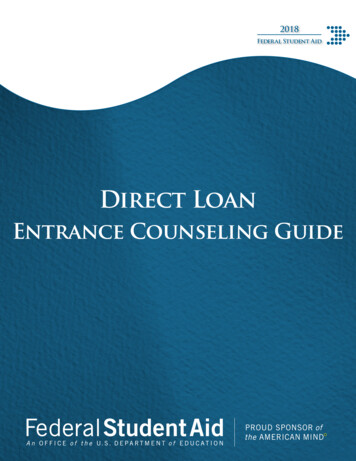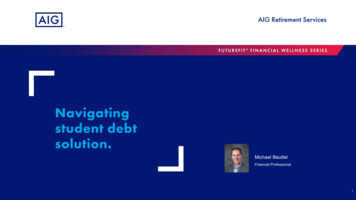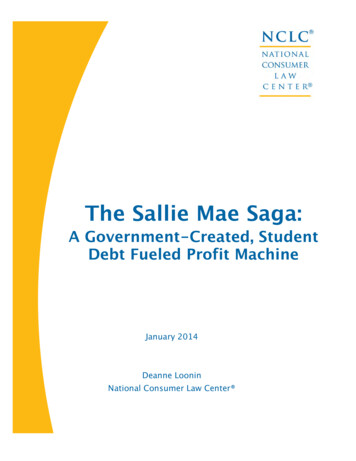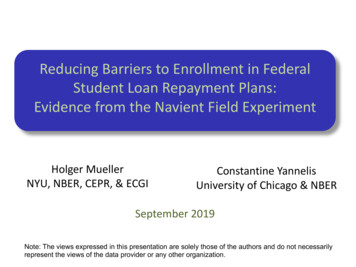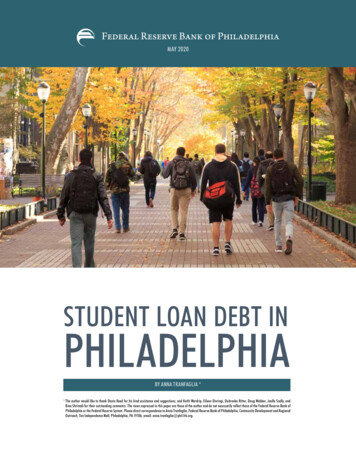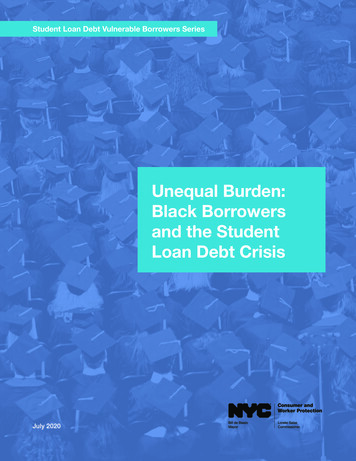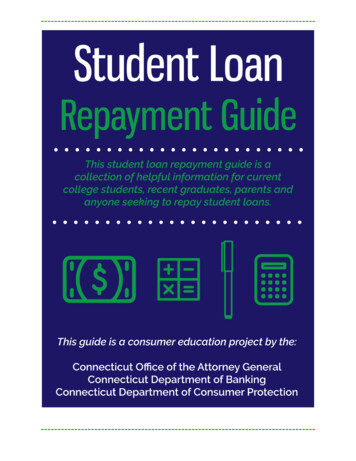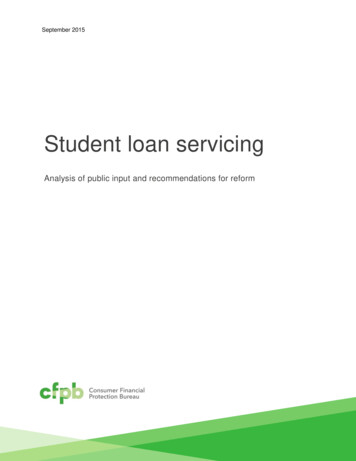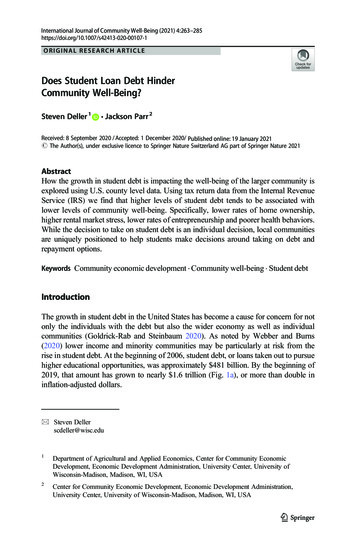
Transcription
International Journal of Community Well-Being (2021) 7-1ORIGINAL RESEARCH ARTICLEDoes Student Loan Debt HinderCommunity Well-Being?Steven Deller 1& JacksonParr 2Received: 8 September 2020 / Accepted: 1 December 2020/ Published online: 19 January 2021# The Author(s), under exclusive licence to Springer Nature Switzerland AG part of Springer Nature 2021AbstractHow the growth in student debt is impacting the well-being of the larger community isexplored using U.S. county level data. Using tax return data from the Internal RevenueService (IRS) we find that higher levels of student debt tends to be associated withlower levels of community well-being. Specifically, lower rates of home ownership,higher rental market stress, lower rates of entrepreneurship and poorer health behaviors.While the decision to take on student debt is an individual decision, local communitiesare uniquely positioned to help students make decisions around taking on debt andrepayment options.Keywords Community economic development . Community well-being . Student debtIntroductionThe growth in student debt in the United States has become a cause for concern for notonly the individuals with the debt but also the wider economy as well as individualcommunities (Goldrick-Rab and Steinbaum 2020). As noted by Webber and Burns(2020) lower income and minority communities may be particularly at risk from therise in student debt. At the beginning of 2006, student debt, or loans taken out to pursuehigher educational opportunities, was approximately 481 billion. By the beginning of2019, that amount has grown to nearly 1.6 trillion (Fig. 1a), or more than double ininflation-adjusted dollars.* Steven Dellerscdeller@wisc.edu1Department of Agricultural and Applied Economics, Center for Community EconomicDevelopment, Economic Development Administration, University Center, University ofWisconsin-Madison, Madison, WI, USA2Center for Community Economic Development, Economic Development Administration,University Center, University of Wisconsin-Madison, Madison, WI, USA
264S. Deller, J. ParrWhile student loan debt remains smaller than consumer credit debt ( 4.1 trillion) ormortgage debt ( 15.5 trillion), the rate of growth of student debt is significant. From2006, consumer credit debt grew approximately 70% and mortgage debt grew by 24%,but student loan debt grew by 232% (Fig. 1b). At the same time, the Consumer PriceIndex increased only 21.1%. Although this may indicate more people attending college,the percentage of high school graduates attending college grew by just four percentageFig. 1 a Debt Trends U.S. (Billion of Dollars), b: Debt Trends U.S. (Growth Index 2006Q1 100)
Does Student Loan Debt Hinder Community Well-Being?265points (65.8% in 2006 to 69.7% in 2016), an increase of 38% in terms of absolutenumber of students (BLS 2017). Meanwhile, debt loads increased. Based on analysisby the Institute for College Access and Success (2018) of survey data from Americanfour-year universities and colleges, the average student debt level increased from 18,650 in 2004 to 29,650 in 2016. Concerns over this rapid growth and thesubsequent impacts on individuals have led some national policymakers to call for fullabsolution of existing student debt. Although the community-level impacts discussedhere may contribute to that narrative, this study seeks to provide communities withinsight and strategies to address the concern locally.This growth in student debt has raised several issues that may affect the economiccompetitiveness of the U.S. as well as individual communities. First, higher educationis increasingly considered a necessity in the modern labor market and people withhigher education tend to be more productive, which is reflected in greater wages andsalaries. The most recent data from the American Community Survey (2018 five-yearestimates) shows that median income for persons with less that a high school degreewas 22,609, rising for those with some college or an Associate’s degree ( 36,293),Bachelor’s degree ( 53,825) and a graduate or professional degree ( 72,095). Assuming a 40-year working life, the difference in median income between a person with ahigh school degree (or GED) and a Bachelor’s degree is 930,200. Over the long term,investing in higher education can have significant impacts on earning potential.Individuals planning on attending higher education institutions who lack fundingmust borrow. But some are questioning the risk-reward calculus of taking on significantdebt to obtain a college degree. In a 2014 survey, 34% of former students age 18 to 40with outstanding debt believed that their investment in a college degree will not pay offin the long run (Citizens Bank 2014). A study of willingness-to-borrow for highereducation found that students from schools with lower resources are less likely toborrow funds for higher education (Perna 2008). Burdman (2005) argued that risingstudent debt loads may be a barrier to access for those who are averse to borrowing.Rising default rates may also contribute to a greater perception of risk associated withstudent loans. If a sufficient number of people decide that the risk associated with debtoutweighs future earning potential, the human capital that a modern competitiveeconomy requires may be at risk.The second issue concerns the inability of students to repay their loans. The simplepresence of student debt reduces an individual’s net worth and disposable income,driving down consumption and investment spending, and places downward pressure onthe economy (Fullwiler et al. 2018). Meanwhile, if a sufficient number of people withstudent debt default, this could lead to a crisis in the educational financing system.Although the mortgage crisis that led to the Great Recession was much larger than thepotential default level on student debt, risks to the financial system are real. Much likethe weakening of the housing market resulted in the ensuing collapse of the mortgagebacked asset securities market and triggered the Great Recession, some scholars such asXu and Ortiz-Eggenberg (2020) suggest that student loan asset backed securities mayequally be at risk.Dynarski (2015) reported that while nearly seven million student loan borrowerswere in default, there is a large variation in the characteristics of those students who arein default. The Institute of Educational Sciences (2018) analysis of those who hadbegun postsecondary education in 2003–04 found that, of students who obtained a
266S. Deller, J. ParrBachelor’s degree or higher, only 3.5% were in default after 12 years and 11% of thoseobtaining an associate degree were in default. But 29.9% of those that experiencedsome college but did not obtain a degree were in default. The same analysis found thatthose in the lower quartile of income after school defaulted at a rate of 21.6%, but forthe highest income quartile, the default status was 11.7%.The vast majority (92%) of student loans, however, are federal which decouplesthem from the traditional financial system. Higher default rates have led some to raiseconcern at the impact on the federal budget (Toby 2011; Edmiston et al. 2013). Thereare additional secondary effects on the traditional financial system. Student debtliabilities are not dischargeable and defaults impact an individual’s credit scores. Again,if student debt default rates grow, it could ripple through the financial system andimpact the federal budget.The third potential crisis is how rising student debt may affect local economies.Numerous authors (e.g., Cornelius and Frank 2015) suggest how student debt might beaffecting the decisions of students post education, including postponing the purchase ofa house or automobile and delaying marriage and/or having children, or starting abusiness. Student debt can alter the behavior of individuals which can impact the largercommunity in which they decide to live. But to what extent and what can communitiesdo to minimize any potential negative outcomes?In addition, some, such as Mascolo (2020), have suggested that rising student debtcould put the future of higher education itself at some level of risk. As tuition and feesincrease at rates faster than inflation or earnings more students will question the riskreward calculus and may opt to delay or forego higher education thus reducingrevenues to institutions of higher education. As we have seen with reduced enrollmentsdue to the COVID-19 pandemic, coupled with changing age demographics, even amodest decline in enrollments can have significant impacts on the fiscal positions ofcolleges and universities. Further, if the student debt market becomes unsustainable forany one of a variety of reasons, students may not be able to obtain the necessaryfinancing further eroding the underlying financing of higher education.To fully understand how student debt could be affecting the community, a systemsthinking approach, such as the Community Capitals (Emery and Flora 2006) or theShaffer Star (Shaffer et al. 2006) could be employed. There are numerous simultaneousmoving parts with significant feedback loops. But within the student debt literature theprimary mechanism through which student debt impacts local economies is throughlabor market decisions. Do new entrants to the labor market limit their job search toonly higher paying jobs, thus avoiding more public service-oriented jobs such asteaching or law enforcement, in order to ensure repayments of debt? Or do these newentrants take any job that is available to ensure some level of income, thus limitingfuture growth? More importantly, do people with student debt avoid entrepreneurshipbecause of the inability to finance a new business and/or the income risk associatedwith being self-employed? This latter employment decision - to become an entrepreneur or not - is important because entrepreneurship is vital to economic growth anddevelopment (Walzer 2007; Haltiwanger et al. 2013). This is particularly true of ruralcommunities (Deller et al. 2019).How student debt impacts each of these questions has an impact on the whole of thecommunity system. For example, there is also growing concern that the stress associated with student debt may harm labor productivity through poor health outcomes
Does Student Loan Debt Hinder Community Well-Being?267(Huang 2015). As levels of financial stress increases - in general and specifically withrespect to student debt - workers are less focused at work, sometimes referred to as“presentism” (present at work but not focused on work), which negatively affectsproductivity. In the extreme case, health concerns become sufficiently severe to resultin unemployment. Indeed, a growing body of research (Kim and Chatterjee 2019;Archuleta et al. 2013; Baker and Montalto 2019) has found direct connections betweengrowth in student debt and health, particularly mental health.In this study, we explore how student debt influences several measures of “community well-being” using U.S. county-level data. We use federal income tax datadrawn from the Internal Revenue Service (IRS) to model how higher levels of studentdebt affect seven different measures of community well-being. To be consistent withthe literature and the systems thinking approach, we define community well-beingbroadly to including elements related to housing, entrepreneurship and health behaviors. For our purposes, each of these are proxy measures of community well-being. Forexample, a higher community well-being is associated with higher rates of entrepreneurial activity, better health behaviors, higher rates of homeownership and lower ratesof rental stress.To measure student debt, we use the county summary statistics from the U.S.Internal Revenue Service. This provides data on the share of tax filers claiming studentdebt repayments on their taxes and the amount of interest payment. Unfortunately,these data are not without their limitations. First, not all tax filers declare student debteven if such a deduction is allowed. Second, there are income thresholds which limitthe ability to declare student debt on federal taxes. While we acknowledge limitationsto this data is the only consistent source of data at the community or regional (i.e.,county) level. The data are for 2016.This study is composed of four additional sections. In the next section, we provide abroad overview of the relevant literature and outline the logic behind how student debtcan influence four indicators of community well-being. We then outline our empiricalmodels and data used in the analysis. We pay particular attention to the student debtdata, specifically its limitations and how the lack of quality student debt data at thecommunity level hinders our analysis. We present our empirical results in the fourthsection followed by a discussion of the implications of our findings on communityeconomic development.LiteratureFrom a community economic development perspective, the relevant literature falls intofour broad categories: labor market outcomes, patterns in entrepreneurship,homeownership decisions, and health outcomes associated with financial stress. Whilethese broad categories are often discussed as separate and distinct issues, there issignificant overlap among them. For example, entrepreneurship, or the decision to beself-employed, is a specific aspect of labor market outcomes. Homeownership can beboth an asset that can influence the ability to start a business and be self-employed(Schmalz et al. 2017) as well as a proxy for the commitment of the person to thecommunity compared to renters who are more mobile. Health outcomes directly andindirectly impact labor market outcomes through lower productivity. Although these
268S. Deller, J. Parrfour indicators are not all inclusive of metrics describing community well-being, theyare tied closely to student debt and include components of various forms of capital thatcontribute to wealth creation in a community.In terms of labor market outcomes, there are generally two competing lines ofthinking. One is that students with higher debt levels will seek any employmentopportunity to ensure some source of income. The other line of thinking is that studentswill seek higher paying but higher risk jobs to compensate for the debt repaymentobligations. The available research (e.g., Minicozzi 2005) tends to favor the secondhypothesis, but the results vary by level of education. Based on the descriptive analysisof the Institute of Educational Sciences (2018) it is clear that not all students who havestudent loan debt obtained the same level of educational outcomes and thosedifferences make drawing broad generalizations about labor market outcomesdifficult. Houle and Addo (2019) detail the heterogeneity in student borrowers, particularly in minority populations and first-generation students.Weidner (2016) finds that an additional 10,000 of student debt reduces earnings byone to 2 % in the first year of employment because higher debt induces some to find ajob more quickly. Thus, a person may take a lower-paying job or a job in a fieldunrelated to their area of study to ensure a flow of income. Price (2004) found thatstudents with an educational debt burden above 8 % of their pre-tax monthly incomesare more likely to earn lower average salaries than their peers with debt below 8 %.This difference became more pronounced for low- or middle-income students as well asracial minorities. Gervais and Ziebarth (2019), however, find no evidence for a negativeeffect of student debt on earnings in the short or long run.A study of students at the University of Virginia (Sullivan 2018) found that studentswith higher debt levels tended toward degrees in business and economics, perhaps withthe understanding that careers in these fields would generate greater returns. Rothsteinand Rouse (2011) find that debt causes graduates to choose substantially higher-salaryjobs and reduces the probability that students choose low-paid “public interest” jobs.These labor market decisions are also present in specific fields. Chambers (1992) foundthat as a law school student’s debt increases, they are less likely to take jobs ingovernment and legal services and more likely to take jobs in large private law firms.Rosenthal et al. (1996) found high levels of student debt had a significant and negativeeffect on the likelihood that medical students will pursue less lucrative family practice.Another element of the labor market outcome question concerns entrepreneurial orself-employment activity. There are at least three potential mechanisms that could linkstudent debt and rates of entrepreneurship. People who were inclined to start a businessbefore assuming student debt may be deterred because of perceived success risksassociated with entrepreneurship. While estimates of business survival rates vary bystudy, a general rule is that 50% of all new startups do not survive after five years(Deller and Conroy 2017). Second, labor income from new ventures is uncertain in thefirst few years. Without guaranteed income, former students may be unable to makedebt payments and support living costs. Third, new businesses may be undercapitalizedbecause student debt limits the ability of the potential entrepreneur from securingsufficient financing. Haltiwanger et al. (2015) observes that the rapid growth in studentdebt levels may correspond to the national slowdown in new business formation.As expected, Krishnan and Wang (2018a, b) find that higher levels of student debtdid deter levels of entrepreneurship for two reasons. First, there is the added risk of
Does Student Loan Debt Hinder Community Well-Being?269insufficient income and business failure to the potential entrepreneur. Second, apotential entrepreneur can have insufficient access to capital due to student debtburdens. For the latter, the potential entrepreneur is unable to invest their owncapital, as it is servicing their student loan debt. In addition, the potentialentrepreneur may be unable to secure more traditional bank financing due to theirgreater existing liabilities. Krishnan and Wang (2018a, b) also found significantadverse effects of student loans on venture capital back startups, particularly highventure capital investment from reputed firms. Ambrose et al. (2015) find this isespecially true for smaller startups (one to four employees), which is particularlytroublesome because most startups tend to be small (Conroy and Deller 2015;Haltiwanger et al. 2013). This cause and effect pattern related to student debt burdensand rates of new business formation could be a fundamental explanation for why theU.S. has experienced increasingly low rates of entrepreneurship (Conroy et al. 2018).Another manner in which student debt can affect the larger community is throughhomeownership. For many communities, particularly smaller and more rural communities, the decision to purchase a home is viewed as a commitment to the community.Renters, on the other hand, can be more transient. Further, homeownership has beenfound to be important in helping understand rates of entrepreneurship. This comes bothfrom the commitment to the community as well as a source of potential financing for abusiness startup or expansion. The latter is due to the impact of homeownership on anindividual’s growth in wealth through equity over time. Some argue that high studentdebt levels are a deterrent to homeownership because of the inability to securefinancing as well as the desire for the person to be more footloose if alternativeemployment opportunities become available, among other factors (Xu et al. 2015).The predominance of the empirical analysis testing this hypothesis seems to supportthe notion that higher levels of student debt is a deterrent to homeownership (e.g.,Cooper and Wang 2014; Elliott and Lewis 2015). There are a handful of studies (e.g.,Houle and Berger 2015; Sommer 2020) that challenge this “conventional wisdom” andfind little evidence that young adults are not buying homes because of student debt.Young adults who are willing to assume student debt may be taking a longer-term viewsurrounding the decision to purchase a home. The higher life-time earnings potential ofthose with higher education outweighs the short-term burden of student debt repayment. This debt burden, however, is becoming increasingly long-term, given that asample of students with debt still owed 22% of the principal after 20 years (Institute ofEducation Sciences 2018).The final element of community well-being that is considered in this study focuseson student debt and health outcomes. It is widely accepted within the public healthliterature and the social sciences literatures more broadly that there is a strong linkbetween personal financial stress and health (O'Neill et al. 2005). In a study of 4897college undergraduate students over a three-year period in the United Kingdom, Cookeand colleagues (2004) found that demographic and economic background did notexplain differences in perceived mental wellness but self-reported perceptions of theirfinances and debt did differentiate mental health scores. Generally, higher levels offinancial stress caused poorer mental health outcomes. This is consistent with Stradling(2001) who found that students who perceived their anticipated student debt as‘excessive’ were more likely to be anxious or depressed than students who viewedtheir anticipated debt as ‘manageable’. Bemel et al. (2016) and their study of
270S. Deller, J. Parrundergraduates at a U.S. university found that fiscal stress impacts many elements ofmental health including concentration, ability to make decisions, general happiness andperceptions of usefulness.Walsemann et al. (2015) also find that poorer financial conditions of students andrecent graduates leads to poorer mental health outcomes, but they note that care must betaken not to make overly general statements about student debt and health. Concurrentwith Huang (2015), risk attitudes towards debt and perceptions of future incomeearning potential plays a significant role. For example, a student who assumes significant levels of debt and has more modest life-long earnings potential will view debtvery differently than a student with higher expected life-long earnings. Also, studentsthat come from families that are more comfortable assuming debt for major purchases(e.g., homeownership) or as a means to finance a business will view student debtdifferently than a first-generation student whose family discourages debt. This observation is consistent with the findings of Dynarski (2015) and The Institute of Educational Sciences (2018), who found significant variations in the characteristics of peoplewho defaulted on their student debts.MethodsThe intent of this study is to explore the impact of student debt on the well-being ofcommunities, where communities are measured at the county level. We explore thecounty as a unit of analysis because of the availability of student debt data and businessstart-up rates at the county level. While using county level data masks importantsocioeconomic and demographic differences within a county, particularly geographically large counties, the IRS data is not available below the county level. Further, mostof the community well-being measures that we model are only available at the countylevel in any consistent manner across the U.S. Based on the available literature, weanticipate that higher levels of student debt will be linked to lower overall communitywell-being. While we do not formally adopt a systems thinking approach (e.g.,Community Capitals or Shaffer Star) to think about the impact of student debt oncommunity well-being, we do define well-being broadly and to be consistent withmuch of the student debt literature.We can express our simple model as:CWBi ¼ α þ j¼1;::;k β j COM i; j þ γSDi þ ϵ iHere, CWBi is a measure of community well-being for community (county) i, COMi, j isa set of k community characteristics reflecting social, demographic and economicconditions, ϵi is the regression error term and α, βjand are γ parameters to be estimated.The variable of interest here is SDi which are measures of student debt for community i.Our central hypothesis is that higher levels of student debt will be associated withpoorer levels of community well-being.Measuring community well-being is subjective because of the normative nature ofwhat defines well-being. For this study, we define well-being across three blocks of
Does Student Loan Debt Hinder Community Well-Being?271variables, housing, entrepreneurship and health, to complement the predominance ofthe literature on student debt and community outcomes. There are two measures ofhousing, two of entrepreneurship and three on health. Naturally, if we adopted a morecomprehensive systems thinking approach to community well-being, there are numerous other measures that could be included such as social capital, financial capital, andpolitical capital amongst others. The number of categories of potential characteristics aswell as the number of potential variables within each category could become unmanageable. Indeed, just within the health category there are dozens of potential individualvariables. To be most consistent with the available student debt literature we haveelected to focus on these three categories.The two housing measures are percent of housing that is owner occupied - a directmeasure of homeownership - and the share of income devoted to rent. Based on theavailable literature tying student debt to lower homeownership rates (Mezza et al. 2016;Xu et al. 2015) and the logic that higher student debt limits the ability of people tosecure a down payment and mortgage financing, we expect higher student debt to placedownward pressure on homeownership. Additionally, individuals with high levels ofstudent debt might be unwilling to assume yet more debt in the form of a mortgage. Ifindividuals with student debt are unwilling or unable to purchase a home, they mustturn to the rental market. Here there is upward pressure on rental prices that may resultin higher rents for a given level of income. We hypothesize that communities, againmeasured by counties, with higher student debt levels will tend to see higher shares ofincome devoted to rents. The housing data comes from the 2016 five-year averageAmerican Community Survey (see Table 1 for descriptive data and data sources).The two measures of entrepreneurship are the percent of households that arereporting any self-employment income and the number of business start-ups per1000 population. The self-employment income data comes from the American Community Survey and the start-up rate data comes from Business Information TrackingSystem (BITS) generated by the U.S. Census Bureau. The reported self-employmentincome data, unfortunately, does not capture the level of household dependency onself-employment income. For example, does someone in the household have a “sideline” business that generates a modest amount of income while the household’s primarysource of income is wage and salary employment? Or is self-employment the predominate source of household income? This simplistic measure cannot provide any insightinto this subtle but important point. The BITS data is built on the same database that isused to generate the County Business Patterns and as such only captures thosebusinesses that have at least one employee. Thus, the sole proprietor that is operatinga home-based business with no paid employees are not included in this analysis.11This data detail raises a challenging question from a community economic development perspective. From apure data perspective, not including non-employer business eliminates “side-line” businesses that, in aggregate, contribute very little to the economy. This focuses attention to only those business that have the shortterm potential to make a larger contribution to the economy. . From a policy perspective, should the limitedeconomic growth and development resources be devoted to helping those small “side-line” businesses with thehope that they grow become viable businesses or should those limited resources be devoted to those “larger”start-ups. . Here “larger” is defined as having at least one paid employee. . There is no clear answer to thispolicy choice and largely hinges on the skill sets that economic development practitioners bring to the table. .The policy issue here is beyond the scope of this study.
272S. Deller, J. ParrTable 1 Descriptive dataMeanS t a n d a r d SourcedeviationPercent of tax returns declaringstudent debt7.342.50Interal Revenue Service (County SummaryReports)Percent of income going tostudent debt0.140.04Interal Revenue Service (County SummaryReports)Student debt interest payment per 1004.55 79.67returnInteral Revenue Service (County SummaryReports)Home ownershipAmerican Community Survey (Census Bureau)71.357.77Percent of income to rent30.155.67American Community Survey (Census Bureau)Percent of households withself-employment Income11.404.02American Community Survey (Census Bureau)Business start-up rate17.458.37County Health Rankings, University ofWisconsin Population Health InstitutePercent of population smoking18.003.51County Health Rankings, University ofWisconsin Population Health InstitutePercent of population drinkingexcessively17.413.31County Health Rankings, University ofWisconsin Population Health InstitutePercent of population withinsufficient sleep33.374.01County Health Rankings, University ofWisconsin Population Health InstituteEducation index1.220.65American Community Survey (Census Bureau) 0.540.76American Community Survey (Census Bureau)Income inequality (Gini)0.450.03American Community Survey (Census Bureau)Economic diversity(Herfindahl index)0.100.02Woods and Poole, Inc0.69Age indexEthnic diversity index0.18American Community Survey (Census Bureau)Percent o
While student loan debt remains smaller than consumer credit debt ( 4.1 trillion) or mortgage debt ( 15.5 trillion), the rate of growth of student debt is significant. From 2006, consumer credit debt grew approximately 70% and mortgage debt grew by 24%, but student loan debt grew by 232% (Fig. 1b). At the same time, the Consumer Price
